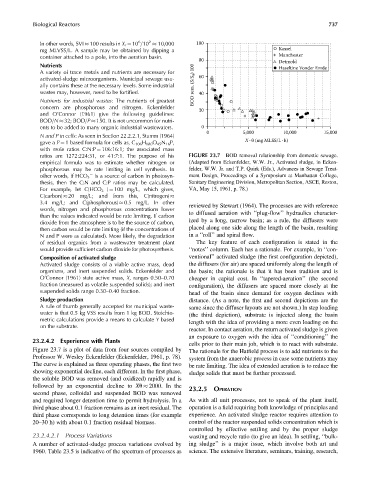Page 782 - Fundamentals of Water Treatment Unit Processes : Physical, Chemical, and Biological
P. 782
Biological Reactors 737
2
6
In other words, SVI 100 results in X r ¼ 10 =10 10,000 100
mg MLVSS=L. A sample may be obtained by dipping a Kassel
container attached to a pole, into the aeration basin. Manchester
80 Detmold
Nutrients Haseltine Vonder Emde
A variety of trace metals and nutrients are necessary for
activated-sludge microorganisms. Municipal sewage usu- 60
ally contains these at the necessary levels. Some industrial BOD rem. (S/S 9 ) 100
wastes may, however, need to be fortified. 40
Nutrients for industrial wastes: The nutrients of greatest
concern are phosphorous and nitrogen. Eckenfelder
20
and O’Connor (1961) give the following guidelines:
BOD=N 32; BOD=P 150. It is not uncommon for nutri-
ents to be added to many organic industrial wastewaters. 0
0 5,000 10,000 15,000
N and P in cells: As seen in Section 22.2.2.1, Stumm (1964)
.
.
gave a P ¼ 1 based formula for cells as, C 106 H 180 O 45 N 16 P, X θ (mg MLSS/L h)
with mole ratios C:N:P ¼ 106:16:1; the associated mass
ratios are 1272:224:31, or 41:7:1. The purpose of his FIGURE 23.7 BOD removal relationship from domestic sewage.
empirical formula was to estimate whether nitrogen or (Adapted from Eckenfelder, W.W. Jr., Activated sludge, in Ecken-
phosphorous may be rate limiting in cell synthesis. In felder, W.W. Jr. and T.P. Quirk (Eds.), Advances in Sewage Treat-
other words, if HCO 3 is a source of carbon in photosyn- ment Design, Proceedings of a Symposium at Manhattan College,
thesis, then the C:N and C:P ratios may be calculated. Sanitary Engineering Division, Metropolitan Section, ASCE, Reston,
For example, let C(HCO 3 ) ¼ 100 mg=L, which gives, VA, May 15, 1961, p. 78.)
C(carbon) 20 mg=L; and from this, C(nitrogen)
3.4 mg=L; and C(phosphorous) 0.5 mg=L. In other reviewed by Stewart (1964). The processes are with reference
words, nitrogen and phosphorous concentrations lower
than the values indicated would be rate limiting. If carbon to diffused aeration with ‘‘plug-flow’’ hydraulics character-
dioxide from the atmosphere is to be the source of carbon, ized by a long, narrow basin; as a rule, the diffusers were
then carbon would be rate limiting (if the concentrations of placed along one side along the length of the basin, resulting
N and P were as calculated). More likely, the degradation in a ‘‘roll’’ and spiral flow.
of residual organics from a wastewater treatment plant The key feature of each configuration is stated in the
would provide sufficient carbon dioxide for photosynthesis. ‘‘notes’’ column. Each has a rationale. For example, in ‘‘con-
Composition of activated sludge ventional’’ activated sludge (the first configuration depicted),
Activated sludge consists of a viable active mass, dead the diffusers (for air) are spaced uniformly along the length of
organisms, and inert suspended solids. Eckenfelder and the basin; the rationale is that it has been tradition and is
O’Connor (1961) state active mass, X, ranges 0.50–0.70 cheaper in capital cost. In ‘‘tapered-aeration’’ (the second
fraction (measured as volatile suspended solids); and inert configuration), the diffusers are spaced more closely at the
suspended solids range 0.30–0.40 fraction.
head of the basin since demand for oxygen declines with
Sludge production distance. (As a note, the first and second depictions are the
A rule of thumb generally accepted for municipal waste- same since the diffuser layouts are not shown.) In step loading
water is that 0.5 kg VSS results from 1 kg BOD. Stoichio- (the third depiction), substrate is injected along the basin
metric calculations provide a means to calculate Y based length with the idea of providing a more even loading on the
on the substrate.
reactor. In contact aeration, the return activated sludge is given
an exposure to oxygen with the idea of ‘‘conditioning’’ the
23.2.4.2 Experience with Plants
cells prior to their main job, which is to react with substrate.
Figure 23.7 is a plot of data from four sources compiled by The rationale for the Hatfield process is to add nutrients to the
Professor W. Wesley Eckenfelder (Eckenfelder, 1961, p. 78). system from the anaerobic process in case some nutrients may
The curve is explained as three operating phases, the first two be rate limiting. The idea of extended aeration is to reduce the
showing exponential decline, each different. In the first phase, sludge solids that must be further processed.
the soluble BOD was removed (and oxidized) rapidly and is
followed by an exponential decline to Xu 2000. In the
23.2.5 OPERATION
second phase, colloidal and suspended BOD was removed
and required longer detention time to permit hydrolysis. In a As with all unit processes, not to speak of the plant itself,
third phase about 0.1 fraction remains as an inert residual. The operation is a field requiring both knowledge of principles and
third phase corresponds to long detention times (for example experience. An activated sludge reactor requires attention to
20–30 h) with about 0.1 fraction residual biomass. control of the reactor suspended solids concentration which is
controlled by effective settling and by the proper sludge
23.2.4.2.1 Process Variations wasting and recycle ratio (to give an idea). In settling, ‘‘bulk-
A number of activated-sludge process variations evolved by ing sludge’’ is a major issue, which involve both art and
1960. Table 23.5 is indicative of the spectrum of processes as science. The extensive literature, seminars, training, research,

